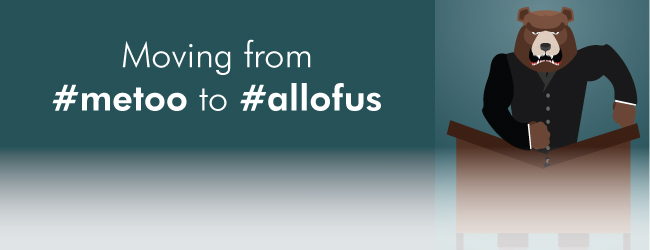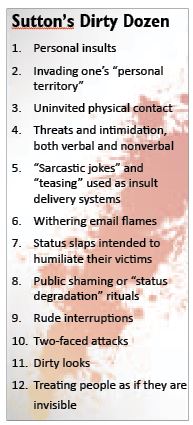
Moving from #metoo to #allofus: Stopping Sexual Harassment by Redefining Workplace Culture
Between 2010 and 2015, the EEOC received 162,872 complaints, and filed charges in more than 6,700 cases alleging sex-based harassment in 2016. But the #metoo movement illustrates there is a drastic underreporting of sexual harassment and sexual assault across industries.
Prohibitions and Penalties are #NotEnough
America has a sexual harassment problem even though sexual harassment has been illegal for half a century. At the federal level, sexual harassment is a form of sex discrimination that violates Title VII of the Civil Rights Act of 1964.1 Title VII applies to employers with 15 or more employees, including state and local governments.2 It also applies to employment agencies and to labor organizations, as well as to the federal government.3 California has adopted the Fair Employment and Housing Act (“FEHA”), which expressly prohibits sexual harassment.4
California defines sexual harassment as unwanted sexual advances, or visual, verbal, or physical conduct of a sexual nature. Sexual harassment may take many forms, but in the workplace it usually falls into two categories: Quid Pro Quo and Hostile Environment.5 Quid Pro Quo occurs when a term of employment is conditioned on the submission to unwelcome sexual advances.6
Hostile work environment sexual harassment occurs when an employee’s work environment is made hostile, offensive, oppressive, intimidating, or abusive due to pervasive sexual harassment.7
Regardless of its form, in California the FEHA requires employers to take “all reasonable steps necessary to prevent discrimination and harassment from occurring.”8 And importantly, all genders and gender identities receive protections from sexual harassment in California. California courts have noted, “the Legislature intended to prohibit sexual harassment in all cases,” not just women and not just opposite-sex harassment.9 And finally, California Government Code section 12940(j) provides that it is “unlawful if the entity, or its agents or supervisors, knows or should have known of this conduct and fails to take immediate and appropriate corrective action.” Even with these laws in place, however, the #metoo movement shows a systemic problem exists.
Robust Policies and Protocols are Just the Beginning
Organizations need effective policies concerning sexual harassment. These policies must: define what sexual harassment is, provide clear examples of sexually harassing conduct, establish a “zero-tolerance” policy, and clearly state consequences for violations. Workplace leaders must exemplify conduct consistent with these policies and violators must be held accountable. EEOC Commissioner Chai Feldblum, who co-authored a review of harassment in the workplace in 2016, explained that perception is key—“people feel free to come forward to report inappropriate advances if they know complaints are taken seriously, investigated, and lead to action.”10
California already mandates two hours of sexual harassment prevention training to all supervisors within six months of hire or promotion, and every two years thereafter for companies with 50 or more employees.11 But, this is a baseline minimum. To truly be effective, organizational leaders must actively participate in sexual harassment training. Eden King, an associate professor at Rice University and sexual harassment training researcher, determined that, “It’s crucial, too, that leaders across every stratum of a company attend training with their employees: not only does this underline the fact that people in power are not immune from disciplinary action if they fail to behave respectfully toward colleagues,” according to King, but it also “conveys the seriousness with which they take the topic and the subject matter.” 12 King posits the most effective training is face-to-face, lasts more than four hours, and includes active participation with a supervisor.
Workplace Leaders Must Aim Higher and Expect Better
A natural response to the continuous wave of #metoo revelations is the call to shore up existing laws and a call for more training. But it would be a missed opportunity if the conversation focused solely on legal regulation, punishment, and trainings. Sexual harassment is not a male or female problem, it is an #allofus problem. It is a workplace culture problem.
To that end, it is partially a leadership problem. Our workplaces need strong leaders equipped and committed to eradicating sexual harassment and the abusive power dynamics that permit sexual harassment to persist. In many respects, the necessary cultural shift goes beyond sexual harassment and calls for a changed mindset around workplace values, gender bias, and power.
During a recent panel of California state Senate and Assembly lawmakers, University of Southern California expert on organizational behavior Janet Denhardt commented, “You can change all of the formal procedures, you can change the structure. That won’t change anything until you change the underlying culture as well.”
From the top down, we must all take responsibility for our workplace cultures and, “If you see something, say something.” With the statistically high percentage of sexual harassment victims being female, to truly transform our workplaces, brave men who find themselves in rooms with other men must call out and halt the “locker room talk” that demeans and devalues women and trends towards sexual violence. These holdover habits should garner a swift rebuke (suggested response: “#dudenotcool.”) While creating pipelines to power that move more women into male-only and male-dominated workplaces, we should reject the notion that a woman’s presence is required to prohibit and police bad adult behavior.
Instead, we should all aim higher to create more civilized workplaces. As an antidote to sexual harassment and other toxic work cultures, leaders should consider Stanford University professor Robert I. Sutton’s The No Asshole Rule: Building a Civilized Workplace and Surviving One that Isn’t. Sutton’s New York Times, Wall Street Journal, and Businessweek best selling book (following his 2005 Harvard Business Review article) fits squarely in the movement to halt sexual harassment in the workplace. Sutton is not addressing his rule to the person having a bad day or someone with a sour demeanor but instead defines a “certified-asshole” is someone with “a persistent pattern” or “history of episodes” that result with “one ‘target’ after another feeling belittled, put down, humiliated, disrespected, oppressed, de-energized, and generally worse about themselves.”13 Sutton provides two tests that help determine whether an organization has a rule violator:14
“Test One: After talking to the alleged asshole, does the “target” feel oppressed, humiliated, de-energized, or belittled by the person? In particular, does the target feel worse about him or herself?
Test Two: Does the alleged asshole air his or her venom at people who are less powerful rather than at those who are more powerful?“
One cannot miss that a sexual harasser’s conduct falls squarely within Sutton’s definition, as a  specific and identifiable subset of the broader problem. According to Sutton, “if someone consistently takes actions that leave a trail of victims in their wake, they deserve to be branded” and removed. In addition, Sutton lists 12 characteristics that certified offenders use to demean, deflate, and dehumanize their victims, consistent with the habits of a sexual harasser.
specific and identifiable subset of the broader problem. According to Sutton, “if someone consistently takes actions that leave a trail of victims in their wake, they deserve to be branded” and removed. In addition, Sutton lists 12 characteristics that certified offenders use to demean, deflate, and dehumanize their victims, consistent with the habits of a sexual harasser.
According to Sutton, organizations should immediately ban their resident jerks from the hiring process and purge them as employees. Once identified, Sutton explains that effective management will should fuel “a virtuous, self-reinforcing cycle between “big” things that organizations do – the stated philosophies; the written policies; the training; and official hiring, firing, and reward practices – and the smaller ways in which people actually treat each other.”15
Establishing a culture of openness, intervention, and accountability is crucial to eliminating sexual harassment in the workplace. Organizations instituting Sutton’s Rule will not only elevate their workplace culture and begin to cull their ranks of those but will also guard against potential sexual harassment activity by sweeping up and sweeping out the sexual harassers in the bunch.
[1] 42 U.S.C. §§ 2000 et seq.
[2] https://www.eeoc.gov/eeoc/publications/fs-sex.cfm
[3] https://www.eeoc.gov/eeoc/publications/fs-sex.cfm
[4] Gov’t Code §§ 12900-12996; specifically Gov’t Code § 12940(j)(4)(C).
[5] Beyda v. City of Los Angeles (1998) 65 Cal.App.4th 511, 516-517.
[6] Fisher v. San Pedro Peninsula Hospital (1989) 214 Cal.App.3d 590.
[7] Accardi v. Superior Court (1993) 17 Cal.App.4th 341, 348–349.
[8] Gov. Code § 12940(k).
[9] Mogilefsky v. Superior Court (1993) 20 Cal.App.4th 1409, 1416.
[10] http://www.businessinsider.com/sexual-harassment-training-effective-2017-11.
[11] Cal. Gov. Code § 12950.1.
[12] http://www.bbc.com/capital/story/20171121-why-sexual-harassment-training-doesnt-work
[13] Sutton, p. 11.
[14] Sutton, p. 11-12.
[15] Sutton at p. 87.